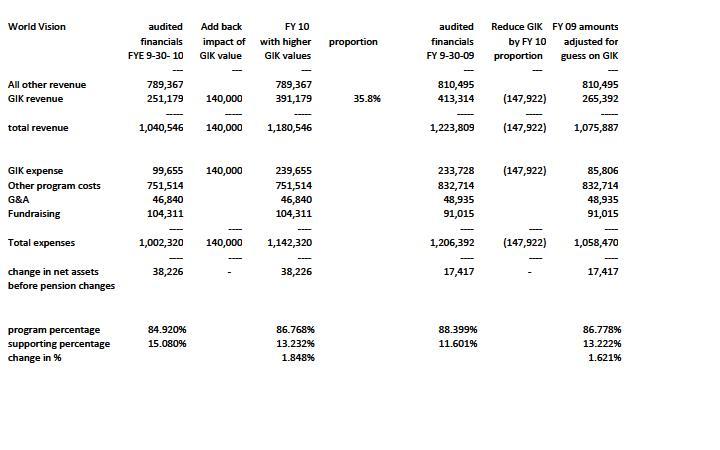Wow. When I started blogging about GIK valuations, I knew there was a major issue, but didn’t quite grasp how big it really is.
The beginning point of my discussion was a Forbes article, by William P. Barrett: Donated Pills Make Some Charities Look Too Good on Paper. In this post I will look at the impact of a change in accounting rules on the valuation of GIKs.
Additional background
Several articles by Caroline Preston in The Chronicle of Philanthropy outline the issues. One deworming medicine, Mebendazole, seems to be the biggest issue. In her article Aid Charities’ Accounting Practices Draw Criticism, she quantifies the significance of that one med:
In 2009 the mebendazole anti-worm pills alone accounted for nearly $900-million of the combined $3.17-billion revenue of five nonprofits that are among the largest in the United States: Crista Ministries (the parent group of aid charity World Concern), Feed the Children, Food for the Hungry, MAP International, and World Vision.
That means 28% of the combined income of those five organizations is from donations of one specific med. I’m just starting to understand the issues, but if I’m getting the picture right, the medicine used overseas at 500 mg is not approved for distribution in the United States. I think that affects our discussion.
If you are an accountant and interested in this issue, I’d suggest you read that article, even though it is behind a paywall. There are a couple of paragraphs that are big deals.
Change in valuation
The accounting rules for fair value recently changed. This is now having an impact on the financial statements of a number of nonprofit organizations that get a lot of GIK. I discussed that here.
I would like to look at a few different organizations to see what the impact is from revised valuations. I will use the methodology I described previously in this post. Since I explained my methodology there, won’t repeat it here.
Impact on World Vision financial statements
The Forbes article provides this information about World Vision:
For many years World Vision, a large faith-based charity in Federal Way,Wash., was one of the most aggressive in valuing deworming pills. In 2009 it used $10.64—the same 53,000% markup used by Crista Ministries. After studying the issue and paying for outside data, it dropped the valuation for 2010 to $2 a pill—a mere 9,900% markup.
Their audited financial statements for the fiscal year ended 9-30-10 are here.
Note 2 on page 16 of the FY 10 financials describes the accounting policy for medical GIKs:
Pharmaceutical GIK contributions of products legally permissible to be sold in the United States are valued using a hierarchy of pricing source inputs that approximates wholesale prices in the United States. Pharmaceutical GIK contributions of products not legally permissible to be sold in the United States, but approved for sale outside the United States, are valued based upon wholesale market price data in countries representing principal exit markets of such products.
The president’s report for 2010 is located here. It provides the following comment about valuation of GIK:
A change in valuation methodology for pharmaceutical products donated to World Vision lowered revenue for the year by about $140 million. This change reflects new accounting rules clarifying how to determine fair market value for donated goods, and applies to all U.S. organizations receiving gifts-in-kind. Certain donated pharmaceuticals, which World Vision had previously valued by reference to U.S. wholesale prices, are now being referenced to wholesale prices in countries representing principal markets for those products (which tend to be lower than U.S. prices).
I pulled numbers from the statement of activity for 2010 and 2009 into a spreadsheet, then did some number crunching. Hey, that’s just how CPAs think.
In 2010, supporting services calculated from the financials were 15.08%. Adding back the $140M impact of reduced GIK valuations mentioned by the president would increase revenue and program services. That would drop the supporting services percentage to 13.23%. That means the higher valuation of GIK that was in use previously would reduce supporting services by 1.85%, which is about 1/7th of the total.
I looked at the 2009 numbers. The impact on FY 10 financials is about 36% of what would have otherwise been the gross amount of GIK (140m / (251m + 140m). If we assume there would be the same proportionate impact on FY 09, the GIK would drop by $148M. So if we pull out $148M from the 2009 GIK income and program expense, the supporting services percentage would rise from 11.60% to 13.22%, an increase of 1.62%.
So summarizing, I calculate the impact on supporting services percentages from different GIK valuation as:
- 2010 – 13.23% with higher GIK valuations and 15.08% using current definition of fair value
- 2009 – 11.60% with higher GIK valuations and 13.22% with new fair value definition
Remember back in algebra class your teacher told you to show your work? I will do the same, for three reasons. First, so you can check my math. Second, so you can revise my assumptions or calculations based on what you think would be a better way to analyze these numbers. Third, so you have a tool to analyze the effect of change in GIK valuations on other NPOs.
Here’s my work. Oh, all amounts in thousands of US dollars.
(click to enlarge)

3 thoughts on “Impact of changing rules for determining fair value (SFAS 157) on GIK of NPOs”